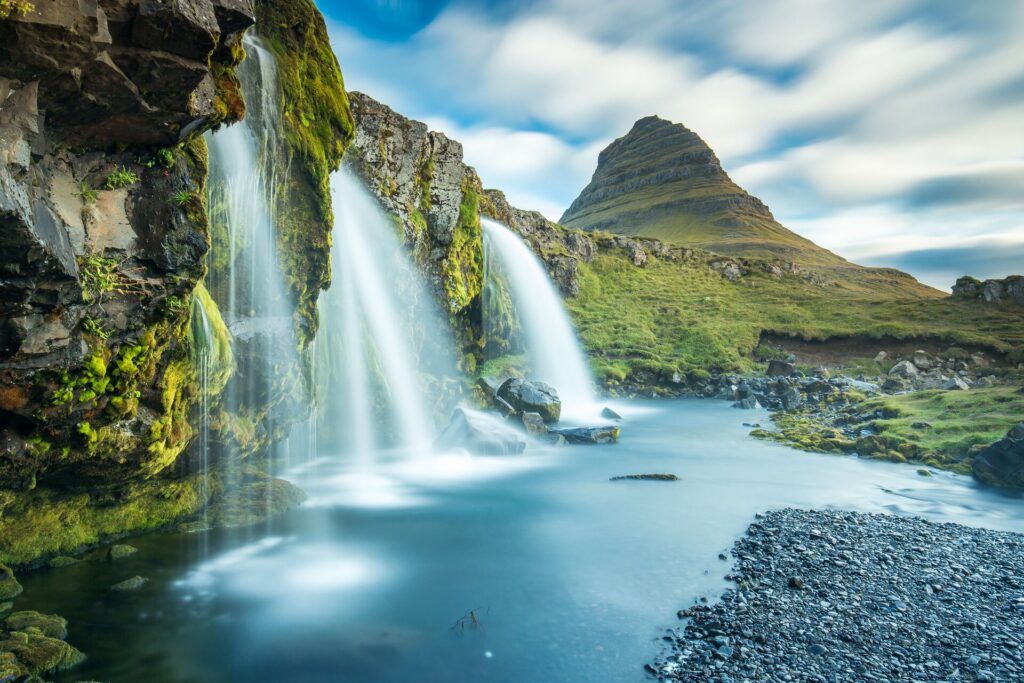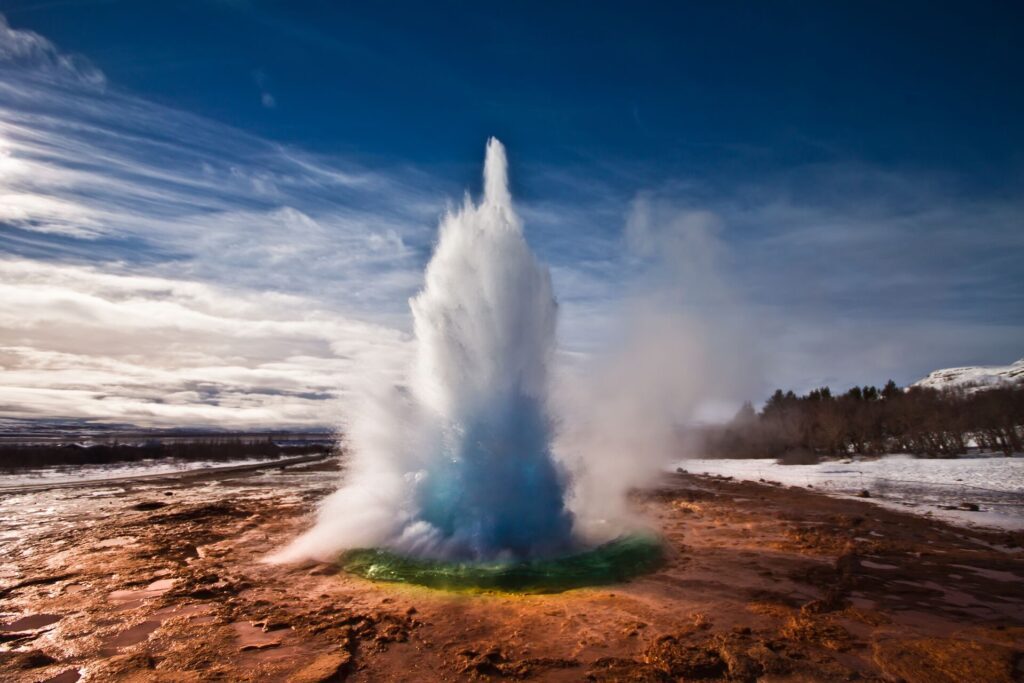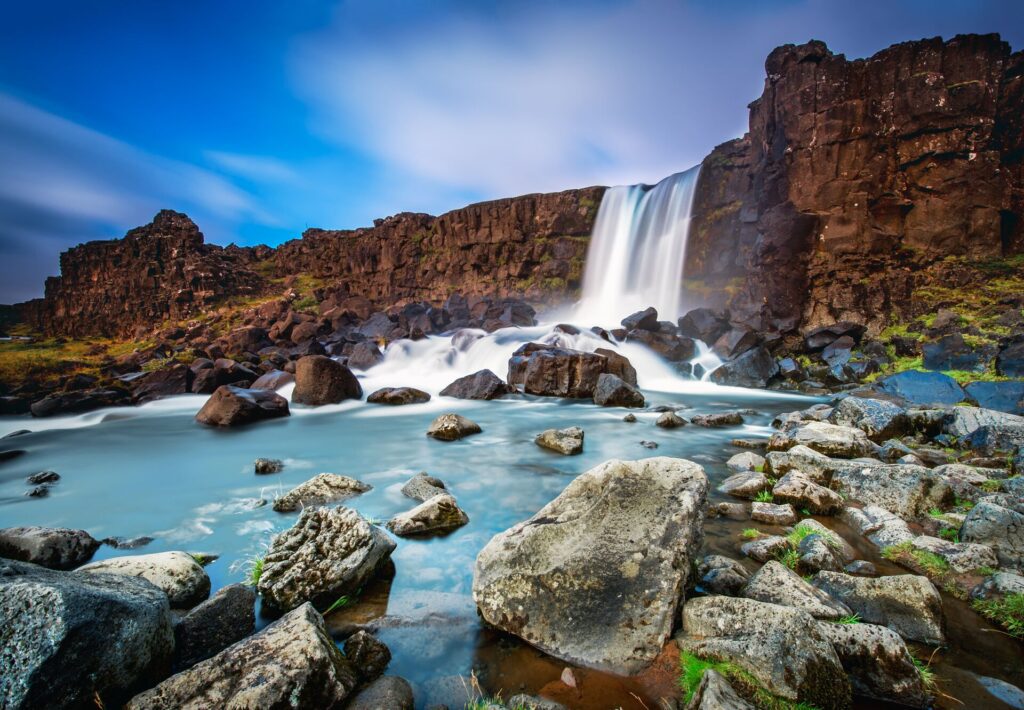On August 12, 2026, a rare total solar eclipse will be visible only from a handful of places on Earth – and Iceland will have a front-row seat. Follow our guide to learn what to expect from this special celestial spectacle, and how to plan your ultimate viewing holiday in the land of fire and ice.
Why the 2026 Iceland Solar Eclipse Is Unmissable
Iceland’s spectacularly unique landscapes will be positioned just beneath the eclipse’s maximum point, so it’ll offer the longest, clearest view.
What is a total solar eclipse?
A total solar eclipse happens when the sun, moon, and Earth are in perfect alignment. This occurs when the moon moves directly between the Earth and the sun, blocking the sun’s light completely and casting a shadow over Earth for a brief period. During this temporary blackout, the sun’s corona (outer atmosphere), stars and planets are clearly visible, making for a magnificent, otherworldly show.
What makes this eclipse special
This intriguing phenomenon occurs somewhere on Earth every 18 months or so. However, because the path of totality is very narrow – usually no more than 200km wide – it’s a rare sight across the world. Parts of Europe had a total solar eclipse 27 years ago, but the last one visible in Iceland was way back in the summer of 1954. In August 2026, the path of totality will also pass over Greenland, Spain and Portugal, but Iceland will have the best view as the totality there will last two minutes and 18 seconds.
Why Iceland is the perfect location
Earth’s closest point to the maximum eclipse will be in western Iceland. While the island’s weather is famously volatile, there’s a good chance of clear skies in August and its lack of light pollution will enhance your view. Plus, Iceland’s picture-perfect volcanoes, glaciers, waterfalls and geysers will add another layer of surreal beauty to the eclipse.


When & Where to See the 2026 Eclipse in Iceland
In August 2026, western Iceland is the place to be. Here’s what to expect…
Date & time of the eclipse
The total eclipse will take place on Wednesday 12 August 2026. The partial eclipse will begin at approximately 4.42pm UTC; then totality will begin at 5.47pm and last for more than two minutes, according to Time and Date.
The path of totality
The path of totality will begin in Greenland, sweeping across Iceland’s western regions, including the Westfjords, Breiðafjörður Bay, the Snæfellsnes and Reykjanes peninsulas, before moving through Portugal and Spain (although only a partial eclipse will be visible in other areas of Europe, North America and Africa). Check out this handy interactive map to see how the show will play out across the globe.
How long will totality last?
The expected maximum duration of totality in western Iceland will be two minutes and 18 seconds.
Is Reykjavík on the path?
Iceland’s capital is slightly outside of the path’s epicentre, so it’ll experience the totality for about a minute. While you’ll have a clearer, longer-lasting show in the western wilderness areas, Reykjavík’s lack of skyscrapers means there’s plenty of open sky to take in the view, and there’ll be a real buzz of excitement in the air as travellers and locals come together to watch the event.


The Best Places in Iceland to View the Eclipse
Iceland’s west coast has pole position, but it’ll still be visible elsewhere around the country. Get your bearings with this interactive Iceland eclipse map, and look out for these hotspots:
Snæfellsnes Peninsula
Just two hour’s drive from Reykjavík and smack-bang on the path of totality, photogenic Snæfellsnes will be the prime spot to witness the astronomical wonder. This area is often referred to as ‘Iceland in miniature’ due to its concentration of natural attractions, including Kirkjufell Mountain, the Snæfellsjökull Glacier, the Kirkjufellsfoss waterfall, and charming villages like Stykkishólmur, Arnarstapi and Hellnar. The 90km peninsula is also famous for inspiring Jules Verne’s Journey to the Centre of the Earth, such is the otherworldly beauty of its lava fields, black-sand beaches, vast caves, craters and basalt formations.
Westfjords
An easy six-hour drive from Reykjavík, the remote Westfjords region is a network of dramatic waterways flanked by undulating landscapes and soaring cliffs, offering minimal light pollution and unobstructed views of the eclipse. Towns here include Ísafjörður, the cultural hub of the Westfjords; Bolungarvík, famous for its Ósvör Maritime Museum, and peaceful Patreksfjörður. Natural attractions include the Dynjandi Waterfall, the Látrabjarg Cliffs puffin-nesting site, Hvítanes’ seal colony, and Hornstrandir Nature Reserve, where arctic foxes may make a cameo.
Reykjanes Peninsula
The Reykjanes Peninsula is just 45 minutes’ drive from Reykjavík and is UNESCO World Heritage Listed as a Global Geopark, its position at the juncture of the Eurasian and North American tectonic plates making it a true geothermal hotspot. It’s home to expansive lava fields; active volcanoes like Krýsuvík and Fagradalsfjall, and geothermal hotspots like Seltún, the Gunnuhver Hot Springs and the Blue Lagoon. Keflavík is the main town here and it’s where you’ll find the international airport as well as the Icelandic Museum of Rock ‘n’ Roll, a scenic harbour and the Viking World Museum. Nearby, the striking Lake Kleifarvatn is surrounded by volcanic terrain while the quaint fishing towns of Grindavík and Þorlákshöfn are also worth visiting. See Iceland’s official website for current updates on the region’s ongoing volcanic activity.
Other notable places
While Iceland’s west will afford the best views, at least part of the eclipse will be visible across the country, with the sun appearing as a barely-there crescent in most other places. For maximum coverage, the best place to be in the east is Neskaupstaður; in the south, Höfn will have the most coverage, and Akureyri is your best bet in the north.


How to Prepare for Eclipse Viewing
Protecting your eyes during the eclipse
To witness the eclipse without causing significant, irreversible damage to your retinas, you’ll need specialised eye protection (your regular sunnies won’t cut it). NASA recommends solar-viewing glasses, certified solar filters for your camera, binoculars and telescopes, and pinhole projectors. While you can briefly look at the sun during the eclipse’s totality, you’ll need to observe the rest of the action indirectly and with full protection. And, as you’ll be outdoors in the direct sunlight for a long period, don’t forget your hat and sunscreen. For more safety suggestions and to create your own eclipse pinhole projector, visit NASA’s eclipse-tips page.
What to pack
Even in summer, Iceland’s weather can be unpredictable – but as the saying goes, there’s no such thing as bad weather, just bad gear, so you’ll need to be ready for anything. A waterproof, windproof jacket and trouser combination creates a protective shell against squalls and waterfalls, and you can layer up beneath it: start with a moisture-wicking base layer, then add a fleece or insulated mid-layer for warmth. Plus, waterproof hiking boots, trekking poles, polarised sunglasses, hat, neck gaiter, gloves, sunscreen, swimwear and lip balm will all keep you covered and comfortable as terrains and conditions change.
Weather conditions to expect
In August, western Iceland offers mild summer weather and long daylight hours, with the sun setting late in the evening. But conditions can change rapidly and unexpectedly, with rain showers, gusty winds and intermittent sunshine sometimes bringing four seasons in one day. According to the Icelandic Meteorological Office, Reykjavík experiences daytime temperatures of 12°C-14°C, with evenings dipping as low as 7°C, but nearby coastal locations may see slightly cooler temperatures and higher humidity.


Tour Options for the 2026 Iceland Solar Eclipse
Here, are all the routes, itineraries and accommodation that’ll level up your eclipse experience.
Popular self-drive itineraries
Exploring Iceland by car, at your own pace, is immersive and rewarding. The Golden Circle Route is a day-trip favourite with travellers as it takes in World Heritage Þingvellir National Park, the explosive Geysir Geothermal Area, and the mighty Gullfoss Waterfall. If you’d like to road-trip for at least a couple of nights, the South Coast Route takes in the powerful Seljalandsfoss Waterfall and Jökulsárlón Glacier. For a more extensive immersion, allow at least a week to explore the Ring Road which takes in Reykjavík, Húsavík, the East Fjords and beyond. While these main roads are well maintained, their secondary routes may be less so, with some consisting of gravel or subject to seasonal closures. So, before you hit the road, check the Icelandic Road and Coastal Administration for updates.
Customisable Tours & Packages
- Adventure World’s six-day Solar Eclipse Adventure offers the ultimate eclipse experience. Perfectly timed to include August 12 and to give you to a front-row seat for the eclipse on the Snæfellsnes Peninsula, this special six-day itinerary departs 10 August 2026 and can be customised for you by one of our Destination Experts. It features a fascinating lecture about eclipses, astronomy and Iceland’s ecology; a rental car for five days with unlimited mileage; hand-picked accommodation; many meals, and sightseeing at Geysir, Gullfoss, Þingvellir, Eyjafjallajökull glacier, the Golden Circle, Kirkjufell Mountain; the Reykjanes Peninsula, Reykjavík, and more.
- Our Leisurely South Iceland itinerary will see you settle in to just three hotels over your seven-day self-drive adventure, giving you plenty of time to explore the Golden Circle, South Shore, and Glacier Lagoon areas. Among countless possibilities, you can opt to explore Þingvellir, Diamond Beach, Skógafoss, the ‘flower village’ of Hveragerði, Gullfoss, Hekla, Geysir, the Eyjafjallajökull volcano, Vik, Vatnajökull National Park, and take a relaxing dip in Flúðir’s thermal springs.
- Spanning eight days of relaxed self-drive touring, the fully customisable Ring Road Highlights journey circuits the country in an anti-clockwise direction and covers all its key attractions. The itinerary’s leisurely pace means you can slow down and maximise your immersion in iconic spots like Þingvellir National Park, the Eastfjords, Vatnajökull National Park, Húsavík, the Reykjanes Peninsula, Jökulsárlón, Höfn, and beyond.
Accommodation tips
Whether you’d like to base yourself in vibrant Reykjavík or venture further afield, it’s important to book your accommodation well in advance, particularly in high-demand areas. August already tends to be a busy month with visitors arriving early for the upcoming aurora season, which starts in September. Around the country you’ll find a range of hotels, guesthouses, cabins, and short-term rentals, but assess the amenities beforehand to ensure the property has heating, blackout curtains, reliable Wi-Fi, and convenient access to eateries or supermarkets for self-catering. To take the guesswork out of where to stay, call Adventure World’s experts on 1300 363 055 in Australia or 0800 238 368 in New Zealand.


Additional Experiences in Iceland
Beyond the eclipse, the land of fire and ice has a hotlist of highlights to thrill and inspire.
Immersive outdoor activities
Summer’s extended daylight hours transform Iceland into an outdoor adventure playground. In Þingvellir National Park, you can dive between two tectonic plates in the Silfra Fissure. Kayaking is especially stellar in the Westfjords and around the Jökulsárlón Glacier, while the Laugavegur multi-day hiking trail; Vatnajökull glacier walks, and the lava tubes of Raufarhólshellir all offer illuminating journeys through unique landscapes. For photographers and nature lovers alike, Lake Mývatn and the Skógafoss and Seljalandsfoss waterfalls are must-sees. Wildlife is abundant across the country too, with excellent whale-watching around Húsavík, Reykjavík and Akureyri, and top puffin tours in Vestmannæyjar, Látrabjarg and the Borgarfjörður Eystri harbour. Prefer to kick back and just take it all in? Soak away the everyday in the Blue Lagoon or in Flúðir’s geothermal pools.
Other attractions worth seeing
The Golden Circle shouldn’t be missed. It includes the UNESCO World Heritage Listed Þingvellir National Park – where Iceland’s first parliament was founded – Gullfoss Waterfall and the geothermal marvel of Geysir. In Reykjavík, visit the country’s tallest building, the Hallgrímskirkja Church; dive into its rich history at the National Museum of Iceland, and head to the Icelandic Phallological Museum for an irreverent but informative look at … biology.


FAQs About the 2026 Iceland Eclipse
Three things to know before you go…
Can I see both the eclipse & Northern Lights?
It’s unlikely, but not completely impossible. Iceland is certainly in the auroral zone, but in the first half of August the daylight hours are extended, with the sun setting around midnight then rising again around 4am. So, once you factor in the extended twilight and the very limited amount of darkness, you may only see the faintest of auroras in August. And only then if the skies are clear, if there’s decent geomagnetic activity and if you’re in the right place to see them. If seeing the aurora tops your Iceland wish list, Adventure World’s Hidden Powers and Northern Lights itinerary maximises your viewing experience in the cooler months and is fully customisable.
Will Iceland be crowded during the eclipse?
Most of the country is uninhabited – in fact, the majority of its 400,000 residents live in the urban areas – but this rare event will attract travellers from far and wide. Key attractions, experiences and accommodations in the more popular areas, and on the path of totality, will no doubt sell out well in advance. It’s best to start locking in things as soon as possible.
When is the next eclipse after 2026?
According to Space.com, in August 2027 a total solar eclipse will be visible from Spain, Morocco, Egypt and Saudi Arabia, with its maximum totality lasting six minutes and 23 seconds. And in 2028, a total solar eclipse will occur over Sydney Harbour.
